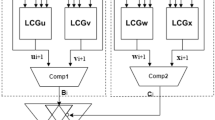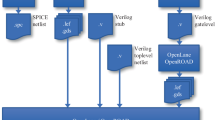Abstract
With increasing availability of software-defined radio platforms, users are no longer tied to receiving or transmitting only one type of signal. In applications, such as signal intelligence, the user may not know ahead of time the characteristics of the signal to be received. This uncertainty results in a need for more flexible receiver architectures that can be easily modified to work for multiple signal types. In this paper the FPGA implementation of a quasi-generic synchronization architecture is presented that is easily adaptable, at implementation time, to most linear modulation schemes. The implementation is shown to work for QPSK, 8QAM, 16QAM and 32QAM with timing frequency errors of up to 4% of the symbol rate.



















Similar content being viewed by others
References
Mitola, J. (1995). The software radio architecture. IEEE Communications Magazine, 33(5), 26–38. http://ieeexplore.ieee.org/xpls/abs_all.jsp?arnumber=393001.
Mitola, J. III, & Maguire, G. Jr. (1999). Cognitive radio: Making software radios more personal. Personal Communications, 6(4), 13–18.
Federal Communications Commission (2003). Facilitating opportunities for flexible, efficient, and reliable spectrum use employing cognitive radio technologies, notice of proposed rule making and order. FCC-03-322.
Wei, W., & Mendel, J. (2000). Maximum-likelihood classification for digital amplitude-phase modulations. IEEE Transactions on Communications, 48(2), 189–193.
Fehske, A., Gaeddert, J., & Reed, J. H. (2005). A new approach to signal classification using spectral correlation and neural networks. In First IEEE symposium on new frontiers in Dynamic Spectrum Access Networks (DySPAN) (pp. 144–150).
Liu, L., & Xu, J. (2006). A novel modulation classification method based on high order cumulants. In International conference on wireless communications, networking and mobile computing, 2006. WiCOM 2006 (pp. 1–5).
Dobre, O., Abdi, A., Bar-Ness, Y., & Su, W. (2007). Survey of automatic modulation classification techniques: Classical approaches and new trends. Communications, IET, 1(2), 137–156.
Suris, J., Recio, A., & Athanas, P. (2008). Rapid radio: Human-assisted signal classification and receiver implementation. In Software defined radio forum technical conference. Washington DC.
Tachwali, Y., Barnes, W., & Refai, H. (2009). Configurable symbol synchronizers for software-defined radio applications. Journal of Network and Computer Applications, 32(3), 607–615.
Zicari, P., Sciagura, E., Perri, S., & Corsonello, P. (2008). A programmable carrier phase independent symbol timing recovery circuit for [qpsk/oqpsk] signals. Microprocessors and Microsystems, 32(8), 437–446.
Brookner, E. (1998). Tracking and Kalman filtering made easy. New York: Wiley.
Gardner, F. (1986). A BPSK/QPSK timing-error detector for sampled receivers/qpsk timing-error detector for sampled receivers. IEEE Transactions on Communications [legacy, pre - 1988], 34(5), 423–429.
Godard, D. (1978). Passband timing recovery in an all-digital modem receiver. IEEE Transactions on Communications [legacy, pre - 1988], 26(5), 517–523.
Simon, M. (2005). Noncoherent symbol synchronization techniques. In Military communications conference, 2005. MILCOM 2005 (Vol. 5, pp. 3321–3327). IEEE.
Recio, A., Suris, J., & Athanas, P. (2009). Blind signal parameter estimation for the rapid radio framework. In Military communications conference, 2009. MILCOM 2009. IEEE.
Dick, C., Harris, F., & Rice, M. (2004). FPGA implementation of carrier synchronization for QAM receivers. Journal of VLSI Signal Processing Systems, 36(1), 57–71.
Dick C., & Harris, F. (2002). FPGA QAM demodulator design. In Field-programmable logic and applications: Reconfigurable computing is going mainstream (pp. 279–287).
Frey, B. J. (1998). Graphical models for machine learning and digital communication. Ser. adaptive and machine learning (pp. 11–15, 133–134). Cambridge: MIT Press.
Volder, J. (1959). The CORDIC computing technique. In IRE-AIEE-ACM ’59 (Western): Papers presented at the the March 3–5, 1959, western joint computer conference (pp. 257–261). New York: ACM.
Acknowledgements
The authors would like to thank the Harris Corporation, Government Communications Division for supporting this research.
Author information
Authors and Affiliations
Corresponding author
Rights and permissions
About this article
Cite this article
Surís, J.A., Recio, A. & Athanas, P.M. On the Implementation of a Quasi-Generic Synchronization Architecture for Linear Digital Modulations. J Sign Process Syst 64, 469–481 (2011). https://doi.org/10.1007/s11265-010-0506-5
Received:
Revised:
Accepted:
Published:
Issue Date:
DOI: https://doi.org/10.1007/s11265-010-0506-5




